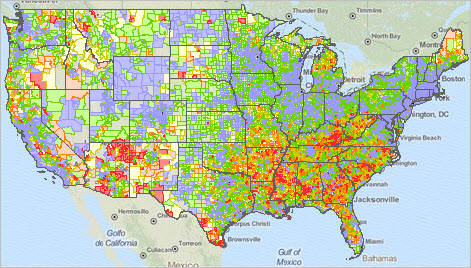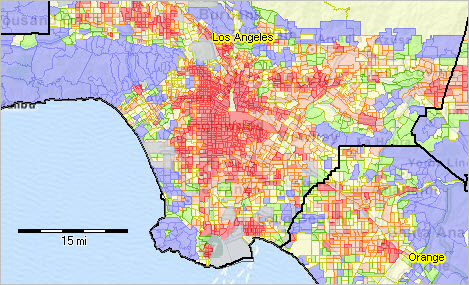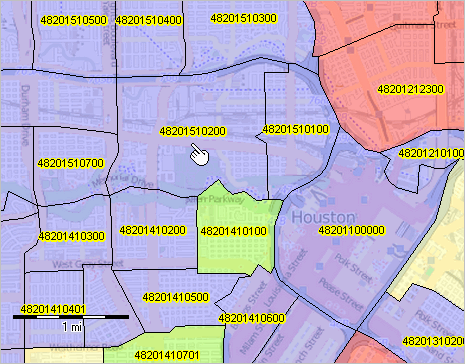

|
|
Census Tract ACS 2015 Economic Characteristics -- tools & data to analyze neighborhood level employment, occupation, income, insurance, poverty, more
Census tracts are important for many reasons. It is easy to misidentify or misunderstand patterns and characteristics within cities, counties and metros which can become blurred using these higher level, more aggregate geographies alone. Many cities and counties that might be experiencing demographic-economic decline will often have bright spots that are groups of a few or many census tracts. This section is focused on tools, resources and methods that you can use to access, integrate and analyze U.S. by census tract economic characteristics data. The U.S. national scope Census Tracts Demographic-Economic Dataset contains approximately 600 subject matter items tabulated for each census tract organized into four subject matter groups: • General Demographics • Social Characteristics • Economic Characteristics (this section) • Housing Characteristics Use the interactive table in this section to view, query, rank, compare general demographics for all tracts in the U.S. Data in this section are based on the American Community Survey (ACS) 2015 5-year estimates. Access to the interactive table below requires your ProximityOne User Group ID. Join now. There is no fee. Current Estimates & Projections ACS tract/small area estimates lag by four years or more between the current year and reference year. There are not annual estimates but estimates based on a 5-year survey. Use the ProximityOne annual tract estimates and projections 2010 through 2022 for current estimates and anticipated change 5 years ahead. Patterns of Economic Prosperity by Census Tract The following graphic shows median household income (item E062 in interactive table below) by census tract based on ACS 5 year estimates. Click graphic for larger view, more detail and legend color/data intervals. This map illustrates the geographic level of detail available using census tract demographics and the relative ease to gain insights using geospatial data analytics tools.  - View developed using CV XE GIS and related GIS project. Patterns of Economic Prosperity by Census Tract -- Los Angeles Metro The following graphic shows the same subject matter as above for a portion of the Los Angeles metro. Accommodating different demographic-economic thresholds/patterns, different legend color/data intervals are used. The pattern layer is set to 80% transparency enabling a view of earth features. Click graphic for larger view, more detail and legend color/data intervals.  - View developed using CV XE GIS and related GIS project. Get a Custom Map for Your Area of Interest Use this form to request a no fee map graphic similar to the one shown above for a county of interest. Enter the request with county name and state in the text section; e.g., "Requesting economic characteristics tract map for Cook County, IL." Use the interactive ranking table in this section to view, query, rank, compare economic characteristics of the population, households and families in these areas. The scroll box shown below lists each of the subject matter items available for each area via the ranking table. The number at the left of the subject matter item is also used as the short name for the subject matter item in the column header in the ranking table. Economic Characteristics Items .. a few item names and numbers changed from previous year data/table.
EMPLOYMENT STATUS
E001 Population 16 years and over E002 In labor force E003 Civilian labor force E004 Employed E005 Unemployed E006 Armed Forces E007 Not in labor force E008 Civilian labor force E009 Unemployment Rate E010 Females 16 years and over E011 In labor force E012 Civilian labor force E013 Employed E014 Own children of the householder under 6 years E015 All parents in family in labor force E016 Own children of the householder 6 to 17 years E017 All parents in family in labor force COMMUTING TO WORK E018 Workers 16 years and over E019 Car, truck, or van -- drove alone E020 Car, truck, or van -- carpooled E021 Public transportation (excluding taxicab) E022 Walked E023 Other means E024 Worked at home E025 Mean travel time to work (minutes) OCCUPATION E026 Civilian employed population 16 years and over E027 Management, business, science, and arts occupations E028 Service occupations E029 Sales and office occupations E030 Natural resources, construction, and maintenance occupations E031 Production, transportation, and material moving occupations INDUSTRY E032 Civilian employed population 16 years and over E033 Agriculture, forestry, fishing and hunting, and mining E034 Construction E035 Manufacturing E036 Wholesale trade E037 Retail trade E038 Transportation and warehousing, and utilities E039 Information E040 Finance and insurance, and real estate and rental and leasing E041 Professional, scientific, and management, and administrative and waste management services E042 Educational services, and health care and social assistance E043 Arts, entertainment, and recreation, and accommodation and food services E044 Other services, except public administration E045 Public administration CLASS OF WORKER E046 Civilian employed population 16 years and over E047 Private wage and salary workers E048 Government workers E049 Self-employed in own not incorporated business workers E050 Unpaid family workers INCOME AND BENEFITS (IN 2015 INFLATION-ADJUSTED DOLLARS) E051 Total households E052 Less than $10,000 E053 $10,000 to $14,999 E054 $15,000 to $24,999 E055 $25,000 to $34,999 E056 $35,000 to $49,999 E057 $50,000 to $74,999 E058 $75,000 to $99,999 E059 $100,000 to $149,999 E060 $150,000 to $199,999 E061 $200,000 or more E062 Median household income (dollars) E063 Mean household income (dollars) E064 With earnings E065 Mean earnings (dollars) E066 With Social Security E067 Mean Social Security income (dollars) E068 With retirement income E069 Mean retirement income (dollars) E070 With Supplemental Security Income E071 Mean Supplemental Security Income (dollars) E072 With cash public assistance income E073 Mean cash public assistance income (dollars) E074 With Food Stamp/SNAP benefits in the past 12 months E075 Families E076 Less than $10,000 E077 $10,000 to $14,999 E078 $15,000 to $24,999 E079 $25,000 to $34,999 E080 $35,000 to $49,999 E081 $50,000 to $74,999 E082 $75,000 to $99,999 E083 $100,000 to $149,999 E084 $150,000 to $199,999 E085 $200,000 or more E086 Median family income (dollars) E087 Mean family income (dollars) E088 Per capita income (dollars) E089 Nonfamily households E090 Median nonfamily income (dollars) E091 Mean nonfamily income (dollars) E092 Median earnings for workers (dollars) E093 Median earnings for male full-time, year-round workers (dollars) E094 Median earnings for female full-time, year-round workers (dollars) HEALTH INSURANCE COVERAGE E095 .. Civilian Noninstitutionalized Population E096 .... With health insurance coverage E097 ...... With private health insurance coverage E098 ...... With public health coverage E099 .... No health insurance coverage E100 .... Civilian Noninstitutionalized Population Under 18 years E101 ...... No health insurance coverage E102 .... Civilian noninstitutionalized population 18 to 64 years E103 ...... In labor force: E104 ........ Employed: E105 .......... With health insurance coverage E106 ............ With private health insurance E107 ............ With public coverage E108 .......... No health insurance coverage E109 ........ Unemployed: E110 .......... With health insurance coverage E111 ............ With private health insurance E112 ............ With public coverage E113 .......... No health insurance coverage E114 ...... Not in labor force: E115 ........ With health insurance coverage E116 .......... With private health insurance E117 .......... With public coverage E118 ........ No health insurance coverage PERCENTAGE OF FAMILIES AND PEOPLE WHOSE INCOME IN THE PAST 12 MONTHS IS BELOW THE POVERTY LEVEL E119 All families E120 With related children of the householder under 18 years E121 With related children of the householder under 5 years only E122 Married couple families E123 With related children of the householder under 18 years E124 With related children of the householder under 5 years only E125 Families with female householder, no husband present E126 With related children of the householder under 18 years E127 With related children of the householder under 5 years only E128 All people E129 Under 18 years E130 Related children of the householder under 18 years E131 Related children of the householder under 5 years E132 Related children of the householder 5 to 17 years E133 18 years and over E134 18 to 64 years E135 65 years and over E136 People in families E137 Unrelated individuals 15 years and over Example To determine the census tracts with the highest median family income in California: - Click ShowAll button. Click State dropdown and select California. - Use horizontal scroll bar to make column E062 visible. - Click once on E062 column header then click once more on E062 column header. - Scroll down to 1st numeric value: tract CA-081-605600 has the highest $MHI among all CA tract codes: 250,000 (top-coded value). Census Tract ACS 2015 Economic Characteristics Interactive Table Access to the table data requires a User Group ID. Join now. There is no fee. Click column header to sort; click again to sort other direction. See usage notes below table. Data based on ACS 2015 5 year estimates. See related interactive tables 73,056 tracts; initial load may require 10 seconds; Click row to copy to clipboard Usage Notes • Tract code column: Census 2010 census tract code structured as 11 characters: - ss (state postal code) + ccc (county FIPS code) + tttttt (Census 2010 census tract code). - all 11 characters required to uniquely identify a tract code. • Use Select Tract button to select one tract: - enter 11-character State+County FIPS code in edit box at right of Tract button. - click ShowAll button. - click Select Tract button to view/analyze selected tract. • Use StCty button to select/filter for all tracts in a county: - enter 5-character State+County FIPS code in edit box at right of StCty button. - click ShowAll button. - click StCty button to view/analyze tracts in this county. • Use CBSA button to select/filter for all tracts in a CBSA/metro: - get 5-character CBSA code from scroll section at right above table. - enter CBSA 5-character code in edit box at right of CBSA button. - click ShowAll button. - click CBSA button to view/analyze tracts in this CBSA. • Click ShowAll button between specific queries. • Cells with -1 value could not be estimated (for this geography and this time frame). Use address look-up tool to determine census tract, city/place and other geocode/area name/demographics based on address. View of Houston Area Showing Tract 48201510200 Create a similar view using the default US1.GIS project distributed with the CVXEGIS software. 
Importance of Census Tracts for Data Analytics Census tracts are important for many reasons. • Covering the U.S. wall-to-wall, census tracts are the preferred "small area" geography for superior data analytics. • The Census Bureau now produces annual tract demographic-economic data from the American Community Survey; .. there is an evolving time-series at the tract level creating new analytical opportunities. • Originally developed to equivalence neighborhoods, many still do. • Defined by the Census Bureau in collaboration with local groups, .. tracts typically reflect boundaries meaningful for local area analysis. • Defined generally for use with each new decennial census, most tract boundaries are stable .. and non-changing for ten years and many much longer. • Designed to average 4,000 population, .. there are more than twice as many census tracts (73,056) than ZIP code areas (33,129). • Tract boundaries are well-defined; unlike ZIP code areas which are subject to multi-sourced geographic definitions. • Many data developers (e.g., epidemiologists) use census tract geography to tabulate their own small area data .. enabling more effective use of those data with Census Bureau census tract data. • A statistical geographic area (in contrast to politically defined areas), .. census tracts are coterminous with counties; .. data at the census tract level can be aggregated to the county level. • Small area estimates for tracts are typically more reliable than for block groups. .. census tracts are comprised on one or more coterminous block groups. .. on average, a census tract is comprised of three block groups. • Census tracts are used by many Federal, state and local governments for compliance and program management. The ACS provides "richer" demographic-economic characteristics for national scope census tracts. While Census 2010 provides data similar to those items in the General Demographics section, only ACS sourced data provide details on topics such as income and poverty, labor force and employment, housing value and costs, educational participation and attainment, language spoken at home, among many related items. The approximate 600 items accessible via the tract dataset are supplemented by a wide range of additional subject matter. ACS census tract data are updated annually in December of each year. Find Geocodes Based on Address go top Summary of steps to use the "Find tract code based on address..." tool located in the upper right of this page. • Enter an address in the three line form (no ZIP code). • Click Find button and the census tract and related geocodes are returned. • Copy the last 11 digits of the returned GEOID to clipboard (e.g., 06085508101). • Paste that value in the edit box to the right of the "Select Area" button below the interactive table. • Replace the first two characters (e.g., 06) with the uppercase USPS state abbreviation (e.g. CA). • Click the Select Area button; the table refreshes with the selected tract. .. optionally right click the row and copy tract attributes to clipboard. .. paste in application such as spreadsheet program. .. join us in a Data Analytics Lab session to review use of operations. • Table empty? Click the ShowAll button then click Select Area button again. Use the Location-Based Demographics tool to view a demographic profile for an address. ProximityOne User Group Join the ProximityOne User Group to keep up-to-date with new developments relating to metros and component geography decision-making information resources. Receive updates and access to tools and resources available only to members. Use this form to join the User Group. Support Using these Resources Learn more about accessing and using demographic-economic data and related analytical tools. Join us in a Data Analytics Lab session. There is no fee for these one-hour Web sessions. Each informal session is focused on a specific topic. The open structure also provides for Q&A and discussion of application issues of interest to participants. Additional Information ProximityOne develops geodemographic-economic data and analytical tools and helps organizations knit together and use diverse data in a decision-making and analytical framework. We develop custom demographic/economic estimates and projections, develop geographic and geocoded address files, and assist with impact and geospatial analyses. Wide-ranging organizations use our tools (software, data, methodologies) to analyze their own data integrated with other data. Follow ProximityOne on Twitter at www.twitter.com/proximityone. Contact us (888-364-7656) with questions about data covered in this section or to discuss custom estimates, projections or analyses for your areas of interest. |
|
|